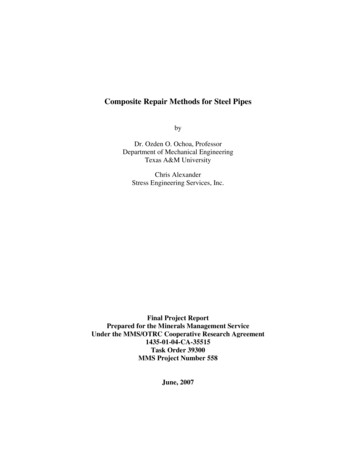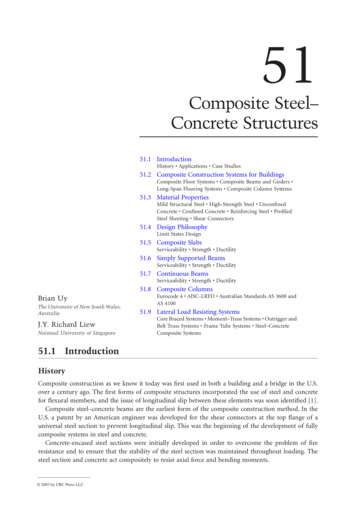
Transcription
Composite Repair Methods for Steel PipesbyDr. Ozden O. Ochoa, ProfessorDepartment of Mechanical EngineeringTexas A&M UniversityChris AlexanderStress Engineering Services, Inc.Final Project ReportPrepared for the Minerals Management ServiceUnder the MMS/OTRC Cooperative Research Agreement1435-01-04-CA-35515Task Order 39300MMS Project Number 558June, 2007
OTRC Library Number: 12/07A184“The views and conclusions contained in this document are those of the authors andshould not be interpreted as representing the opinions or policies of the U.S.Government. Mention of trade names or commercial products does not constitutetheir endorsement by the U. S. Government”.For more information contact:Offshore Technology Research CenterTexas A&M University1200 Mariner DriveCollege Station, Texas 77845-3400(979) 845-6000orOffshore Technology Research CenterThe University of Texas at Austin1 University Station C3700Austin, Texas 78712-0318(512) 471-6989A National Science Foundation Graduated Engineering Research Center
TABLE OF CONTENTSEXECUTIVE SUMMARY . 1BACKGROUND . 2INTRODUCTION . 4DESIGN AND DEVELOPMENT. 6INSTALLATION AND IMPLEMENTATION . 9OPERATIONS AND MAINTENANCE. 11CONCLUSIONS. 12REFERENCES . 14Appendix A - Recommended Tests . A-1Appendix B – Workshop Proceedings. B-1Appendix C – Workshop Presentations . C-1
DEVELOPMENT OF GUIDELINES FOR THEREPAIR OF RISERS USING COMPOSITE MATERIALSEXECUTIVE SUMMARYFor the past decade the use of composite materials in repairing offshore systems has beenof interest to operators and regulators. Risers are one of the most important elements inan offshore system and are often susceptible to damage and degradation including outsideimpact and corrosion. While risers have been repaired using composite materials, to datethere has not been a program to specifically assess the use of this technology relative tomechanical integrity requirements. For this reason MMS sponsored a research programstarting in 2006 with the Offshore Technology Research Center (OTRC) to assessexisting composite repair technology. One primary aim of this work was to developguidelines to assist regulators, operators, and manufacturers in using compositetechnology to repair risers.The development of this guideline is based on findings of the funded research that alsoinvolved co-sponsored research activities from four manufacturers in the form of a jointindustry project (JIP). The aim of this document is to provide guidance to industry interms of the following areas: (1) design and development, (2) installation andimplementation, and (3) operations and maintenance. The sections that follow providedetails on each of these areas, with each serving a critical role in the deployment ofeffective repairs for long-term service.Also included is information presented and gathered at a workshop hosted by the OTRCat Stress Engineering Services, Inc. in Houston, Texas on March 29, 2007. The workshopwas attended by representatives from MMS and other regulatory bodies, academia andresearch organizations, oil and gas companies, service/consulting firms, and compositerepair manufacturers. A beneficial exchange of information and ideas took place asparticipants learned about the background of composite repairs as well as the criticalaspects of integrating this technology for the repair of offshore risers.-1-
BACKGROUNDComposite repair systems have been used to repair damaged pipelines for almost 20years. The majority of this remediation work has involved the repair of onshore pipelinessubject to corrosion. Repairing corrosion in this manner involves the restoration of hoopstrength, and as any review of the open literature will demonstrate, addressing this stressstate has been the primary focus of research efforts up to this point in time (1-5).1Additionally, mechanical damage (e.g. dents with gouges) has been repaired usingcomposite materials (6, 7). Information available to industry is based in large part on theresults of several research programs that integrated composite coupon tests, as well asfull-scale burst and fatigue testing on pipelines with simulated damage.The ASME codes for gas (ASME B31.8) and liquid (ASME B31.4) pipelines address theuse of composite materials (10, 11). However, more recently, ASME has developed adocument focused on the repair of pressure equipment, PCC-2-2006 Repair of PressureEquipment and Piping Standard (12). Article 4.1 of this document, Non-metallicComposite Repair Systems for Pipelines and Pipework: High Risk Applications, providesdetails on how composite materials are to be used to repair pipes. Specifically, the repairsystem is defined in this document as the combination of the following elements forwhich qualification testing has been completed: substrate (pipe), surface preparation,composite material (repair laminate), filler material, adhesive, application method, andcuring protocol. What is not specifically addressed in the ASME document is the repairof offshore pipelines or risers.The engineering community to a large extent has relied on existing research to assess theuse of composite repair technology. In terms of repairing offshore pipelines and risersthat are subject to loads different than their onshore counterparts, there is a gap in theinformation technology. As a point of reference, onshore pipelines are typicallyconcerned with circumferential stresses associated with internal pressure. However, inaddition to internal pressure, offshore risers are subject to tension and bending loads due1Numerical values provided in parentheses correspond to documentation cited in the Reference section.-2-
to their suspended nature in the water. For this reason, any composite system used torepair offshore risers should address these loading conditions to ensure that the systemperforms as intended. Several operators have used composite materials to repair offshorerisers (13). In spite of the use of this repair technique, many in the industry recognize theneed for additional research to address the use of composite materials in repairingoffshore riser systems. Through additional investigations, industry will gain insightsregarding the capabilities and limitations that exist with current composite technology.-3-
INTRODUCTIONAs stated previously, this guideline is intended to be a resource for regulators, operators,and manufacturers. To effectively assess composite technology, and in particular anyspecific repair system, it is important to divide the assessment process into severalspecific subject areas. The first involves design and development. This subject areainvolves ensuring that the composite technology has been designed with the appropriateservice conditions in mind, and most importantly, that the manufacturer has properlyaddressed and accounted for factors that can lead to inadequate performance and longterm degradation. It is the responsibility of the manufacturer to ensure that the design oftheir particular system meets minimum design and service requirements. It is recognizedthat enforcement and performance requirements will likely come from operators andregulators. The second subject area concerns installation and implementation. History hasshown that even with the best designs, when technology is not properly used the potentialfor sub-standard performance exists, sometimes with catastrophic results. For this reason,guidelines are provided herein to ensure that the repair of risers is done correctly, with anemphasis on quality assurance and consistent methodology. The third subject areaconcerns operations and maintenance. Once the composite materials have been installed,it is important for operators to conduct periodic inspections and perform maintenance asappropriate. Long-term performance is directly related to how well the compositematerials are protected and maintained. Failure to properly maintain these repair systemswill result in sub-standard performance.The sections that follow provide specific discussions on the three above-mentionedsubject area topics. While not overly-prescriptive, the intent is to provide generalguidelines to be used by industry to assess existing technology and develop newcomposite repair systems as required to address the ever-increasing demands of offshoreconditions (such as deep water applications). In large part, these guidelines are a directresult of insights gained in performing tests associated with the MMS-sponsored JIPprogram.-4-
Several appendices are provided that provide specific information. Appendix A providesa list of recommended material testing that should be performed to assess theperformance of any repair system used to repair offshore risers. In Appendix B one findsthe proceedings of the workshop on repair of risers using composite materials, Repair ofRisers Using Composite Materials Workshop, held at Stress Engineering Services, Inc. onMarch 29, 2007. The final appendix, Appendix C, contains copies of the presentationsmade at the workshop.-5-
DESIGN AND DEVELOPMENTFrom a recommendation standpoint, this guideline does not favor any one particularcomposite repair technology over another. It is recognized that whether a manufacturerelects to use carbon or E-glass, epoxy resin or urethane, or pre-cured or in situ cured, thereason for doing so will largely be determined by technology requirements and economicviability. However, it is possible to provide guidelines that specifically addresstechnology requirements when composite materials are used to repair offshore risers.The sections that follow provide a list of design requirements, as well asrecommendations for manufacturers to consider in documenting that their particularsystem satisfies the appropriate design requirements.Design RequirementsThe list below captures design elements that should be specifically addressed bymanufacturers in the development of their system. The primary means of verifying that aparticular system meets the design requirements should involve full-scale testing,preferably efforts that involve testing to failure in order to determine the limit capacityfor a particular repair system.1. Loading assessment – the composite repair system should be designed to provideadequate reinforcement to the steel riser pipe considering all possible loads. As aminimum, these loads should include internal pressure, tension, and bending. Otherpossible load requirements include impact from external forces, and fatigue loading.2. Allowable stress and strain states – the composite system must evaluate theperformance of two components: the repaired steel and the composite reinforcingmaterial. Using available design codes such as API RP 1111 and ASME B31.8, thesystem must ensure that stresses and strains within each respective component areless than a specified maximum value. As a point of reference, consider the following:-6-
a. Steel riser material – once the repair is installed, the stress (or strain) in thesteel should be reduced when subjected to increased loading to the pointwhere plasticity initiates in the steel due to increased compliance. To increasethe level of reinforcement, conventional methods employ a composite withgreater stiffness by either increasing the composite thickness or selecting amaterial having a greater elastic modulus.b. Composite material – unlike steel whose mechanical properties do notdegrade over time due to sustained loading, the properties of compositesystems can degrade over time (often due to degradation of the resin). For thisreason, any repair using composite materials must consider the degraded longterm strength as part of the design. By designing so that the stress in thecomposite material is less than a specified threshold, long-term performance isenhanced.3. Material qualification – composite materials are identified based on their particularconstituent components including fiber and matrix selection. Material qualification isa critical aspect of the design process. Appendix A provides a list of therecommended tests based on ASTM procedures.4. Repair life – the design of the repair system should adequately address long-termperformance requirements. This includes accounting for all load types, environmentaleffects, and material degradation.5. Geometry of repair – the geometry of the repair should be based on soundengineering principles. The governing factors for the design include the extent ofdamage to the riser (e.g. corrosion depth and length) and material properties of thecomposite including stiffness, tensile strength, elongation to failure, and adhesive lapshear strength. These factors will be used to determine the thickness and length of therepair.-7-
6. Type of repair – it is important as part of these guidelines to establish whatconstitutes an acceptable repair. External corrosion associated with general materialloss and dents and scratches are covered as part of this guideline. It should be notedthat whatever defect is repaired, applicable design and fitness for service codesshould be referenced to ensure that the repair of inappropriate defects does not occur.This guideline does not encourage or endorse the repair of leaking defects.7. Environmental and operating factors – the design of the composite repair shouldproperly address all potential environmental and operating factors. Examples includeUV exposure, wet/dry conditions, elevated temperatures and temperature extremes,long-term exposure to sea water, and potential for exposure to aggressive chemicals.It is noted that the composite repair systems maybe exposed to fire and open flames.This can be mitigated by additives in the resin and external fire retardant coatings forfire. In areas where exposure to fire is possible, it is important that this be done. Evenif the composite repair system does not catch fire, exposure to elevated temperatureswill result in loss of strength which could result in failure of the repair, possiblyleading to catastrophic failure of the repaired piping.8. Susceptibility to damage – although perhaps more related to discussions onoperations and maintenance, the design process should consider the effects of externaldamage and how a particular system not only withstands damage, but also how thesystem can be repaired if necessary. Part of this process involves assessing damagetolerance before issues arise in the field.-8-
INSTALLATION AND IMPLEMENTATIONThe successes and failures in using composite materials to repair pipelines in the fieldhave largely been related to issues associated with installation and implementation. tothemanufacturer’srecommendations, they typically perform as designed. However, when improperinstallation techniques are used, the likelihood for inadequate performance issignificantly increased. This section of the guideline is intended to help manufacturersdevelop appropriate installation techniques, as well as providing for operators andregulators key points of interest to monitor during the installation of repairs.Provided below is a list of important topics associated with the installation of compositerepair systems offshore.1. Documentation – it is important that manufacturers have documentation available foroperators and regulators that covers the following subject matters:a. Material performance data including MSDS sheetsb. Details on design basis and testing programc. Quality control procedures including material traceability and trackingd. Installation procedures with details as appropriate including minimum curetimese. Forms for detailing specific elements of the repair procedure and how therepair conforms to manufacturer’s recommendations.2. Installation procedures – to ensure quality installation, it is important thatinstallation procedures be developed so that each repair is performed consistently andin a manner that meets certain workmanship standards. Additionally, the proceduresshould provide details on what to do when untoward conditions occur duringinstallation. An example includes what to do when a resin does not cure in theappropriate time period.-9-
3. Assessing quality of installation – this has historically been the primary problemwith field installation of composites. When failures have occurred, they most ofteninvolve the improper allocation of resin and also using resins that fail to cure. Wheneither of these conditions exists, the performance of the repair will not meet minimumrequirements. Operators and regulators should ensure that the resins have beenproperly installed and that curing has occurred as specified by the manufacturer.- 10 -
OPERATIONS AND MAINTENANCEUnlike buried pipelines where repairs are largely unseen, offshore repairs are exposed tothe elements including weather, sea conditions, and the possibility for impact withoutside forces. For this reason, it is recommended that periodic inspection of the repairsbe made when possible. Provided below are examples of some facets of the repairs thatshould be inspected:1. Inspecting for external damage associated with impact.2. Looking at the ends of the repair to assess the possibility for moisture ingression.3. Evaluating if any loads have been applied to the repair that exceed the original designvalues (this is especially important in hurricane conditions).4. On a periodic basis, selected regions of the repair should be inspected for possibledelamination.5. If the repair has been painted to protect against exposure from UV light, inspectionshould ensure that no exposed surfaces exist.6. Operators should document inspection efforts as part of a formal fitness for purposeinspection program.7. If sub-standard conditions are found to exist, the composite system should be repaired(if possible), or replaced if remediation options do not exist.- 11 -
CONCLUSIONSDue to the complex loads associated with repairing risers, the offshore industry has beencautious and methodical in accepting the use of composite materials as a means forreinforcing corroded and damaged risers. It is possible, under the right conditions, thatcomposite materials can be used to repair offshore risers in the area of splash zone. Inorder for this to take place, the user must have a clear understanding of the loadsimparted to the riser and be technically confident that the selected composite materialscan provide an adequate level of reinforcement.The fundamental objective of this effort has been demonstrated in the four-team JIPprogram conducted by Stress Engineering Services, Inc. This full scale test programevaluated four different composite repair systems. The program incorporated 8.625-inchx 0.406-inch, Grade X46 pipe test samples that were fitted with simulated corrosion bymachining. The program involved destructively testing three samples repaired by eachrespective composite repair system. The three tests included a burst test (increasingpressure to failure), a tension to failure test (pressure with increasing axial tension loadsto failure), and a four-point bend test (pressure and tension held constant with increasingbending loads to achieve significant yielding in steel).It should be recognized that the primary purpose of the JIP study was to identify andconfirm the critical elements required for an effective composite repair. Havingpractically unlimited access to manufacturers with the ability to understand the overallmechanics of each repair, the author was provided with insights useful for developing anoptimized repair system. Other benefits were also derived in the execution of theprogram, including the development of guidelines for industry and regulators andproviding the manufacturers with the opportunity to assess their repair systems relative toloading conditions associated with offshore risers. In using composite materials toreinforce damaged and corroded risers, it is critical to integrate a design methodology thatassesses the strain in the reinforced steel. This is especially important in offshore designas risers in the splash zone are subjected to combined loads including internal pressure,- 12 -
axial tension, and bending loads, as compared to onshore repairs that primarily involverestoration of hoop strength. As has been demonstrated in this presentation, use of strainbased design methods is the ideal approach for assessing the interaction of load transferbetween the reinforced steel and the reinforcing composite material. Industry should becautious of any design methodology that does not capture the mechanics associated withthe load transfer between the steel and composite materials during the process of loading.The two keys are to first determine strain limits based on acceptable design margins, andthen assess strain levels in both the steel and composite reinforcement using eitheranalysis methods, or the preferred approach involving full-scale testing with strain gages- 13 -
REFERENCES1. Pipeline Safety: Gas and Hazardous Liquid pipeline Repair, Federal Register, Vol.64, No. 66, Wednesday, April 7, 1999, Proposed Rules, Department ofTransportation, Research and Special Programs Administration, Docket No. RSPA98-4733, Notice 1.2. Fawley, N. C., Development of Fiberglass Composite Systems for Natural GasPipeline Service, Final Report prepared for the Gas Research Institute, GRI-95/0072,March 1994.3. Stephens, D. R. and Kilinski, T. J., Field Validation of Composite Repair of GasTransmission Pipelines, Final Report to the Gas Research Institute, Chicago, Illinois,GRI-98/0032, April 1998.4. Kuhlman, C. J., Lindholm, U. S., Stephens, D. R., Kilinski, T. J., and Francini, R. B.,Long-Term Reliability of Gas Pipeline Repairs by Reinforced Composites, FinalReport to the Gas Research Institute, Chicago, Illinois, GRI-95/0071, December1995.5. Block, N., and Kishel, J., Clock Spring Reinforcement of Elbow Fittings, TopicalReport prepared for the Gas Research Institute, GRI-93/0346, December 1995.6. Alexander, C. R., Pitts, D. A., Evaluation of the AquawrapTM System in RepairingMechanically-damaged Pipes, report prepared for Air Logistics Corporation, Azusa,California, September 2005.7. Alexander, C.R., Wilson, F.D., Recent Test Results and Field Experience with ArmorPlate Pipe Wrap Repairing Corroded and Mechanically-Damaged Pipes, 2000Pigging Conference, Houston, Texas, February 2000.8. Pipeline Safety: Gas and Hazardous Liquid pipeline Repair, Federal Register, Vol.64, No. 239, Tuesday, December 14, 1999, Rules and Regulations, Department ofTransportation, Research and Special Programs Administration, Docket No. RSPA98-4733; Amdt. 192-88; 195-68 (Effective date: January 13, 2000).9. American Society of Mechanical Engineers, Manual for Determining the RemainingStrength of Corroded Pipelines, ASME B31G-1991, New York, New York, 1991edition.10. American Society of Mechanical Engineers, Gas Transmission and DistributionPiping Systems, ASME B31.8, New York, New York, 2003 edition.11. American Society of Mechanical Engineers, Liquid Transportation System forHydrocarbons, Liquid Petroleum Gas, Anhydrous Ammonia and Alcohols, ASMEB31.4, New York, New York, 2003 edition.12. PCC-2-2006 Repair of Pressure Equipment and Piping Standard, ASME, New York,New York, 2006 edition.13. Personal communication with Mr. Paul Moise of Armor Plate, Inc., September 2006.- 14 -
Appendix A - Recommended TestsPage A-1
Recommended TestsThe following list comprises tests that should be considered as part of the development ofany composite repair system. The test results should be documented and preferablyperformed by a third-party test lab. As noted, some tests referenced use the appropriateASTM designation. Test results should include the following, preferably in a singledocument that can be provided upon request by the manufacturer. Tensile Strength per ASTM D3039 Tensile Modulus per ASTM D3039 Compressive Strength of Filler Materials per ASTM C579 Shear Strength per ASTM D5379-05 Shear Modulus per ASTM D5379-05 Shear Failure Strain per ASTM D5379-05 Thermal Expansion per ASTM E 831 Glass Transition per ASTM D660 Poisson’s Ratio per ASTM D3039 Barcol Hardness per ASTM D2583 Flexural Modulus per ASTM D790 Hydrostatic Burst Test per ASTM G42-95 Cathodic Disbondment per ASTM G 95-87 Abrasion Resistance Lap Shear Adhesive Test per ASTM 3163 (surface preparation per ASTM 2093) Cathodic Disbondment per ASTM G42 Pull-Off Adhesion per ASTM D454 Impact Resistance per ASTM G14In addition to the above tests, for repair of risers it is recommended that a specific testprogram be designed that includes the following loads:1. Internal pressure2. Axial tension3. BendingPage A-2
The test program should ensure that the composite repair system reduces strains in therepaired section of the steel test pipe to below a specified level.Additionally, it is critical that the composite repair system demonstrate adequate longterm performance for the intended design life.Page A-3
Appendix B – Workshop ProceedingsPage B-1
Repair of Risers Using CompositeMaterials WorkshopbyDr. Ozden O. Ochoa, ProfessorDepartment of Mechanical EngineeringTexas A&M UniversityChris AlexanderStress Engineering Services, Inc.Workshop ProceedingsPrepared for the Minerals Management ServiceUnder the MMS/OTRC Cooperative Research Agreement1435-01-04-CA-35515Task Order 39300MMS Project Number 558March 29, 2007
OTRC Library Number: 4/07CPWS“The views and conclusions contained in this document are those of the authors andshould not be interpreted as representing the opinions or policies of the U.S.Government. Mention of trade names or commercial products does not constitutetheir endorsement by the U. S. Government”.For more information contact:Offshore Technology Research CenterTexas A&M University1200 Mariner DriveCollege Station, Texas 77845-3400(979) 845-6000orOffshore Technology Research CenterThe University of Texas at Austin1 University Station C3700Austin, Texas 78712-0318(512) 471-6989A National Science Foundation Graduated Engineering Research Center
Table of ContentsTable of Contents. iExecutive Summary . 1Background and Objectives . 1Workshop Organization . 1Recommendations. 2Acknowledgements. 3Appendix A. 5Workshop Agenda . 5Workshop Participants . 5i
Repair of Risers Using Composite Materials WorkshopO. O. Ochoa, Texas A&M UniversityC. Alexander, Stress Engineering Services, Inc.Executive SummaryBackground and ObjectivesThis one day workshop shared the results of an MMS sponsored research project atOTRC focused on developing guidelines to assist regulators, operators, andmanufacturers in using composite technology to repair steel risers and tubulars.Glass reinforced polymer systems have been routinely used to repair corrosion damagedonshore pipelines in the last two decades. These repair systems restore hoop strength.However in addition to internal pressure, offshore risers and pipelines are subject totension and bending loads, and thus require an extension of repair performance to addresscombined loading.The objective of the workshop was to introduce and discuss a recommended repairapproach and metrics that addressed:i.ii.iii.Design and developmentInstallation and implementationOperation and maintenanceThe workshop presentations and discussions highlighted the assessment of existingtechnology as well as development of new composite repair systems for future deepwater considerations.Workshop OrganizationThe workshop was initiated and sponsored by OTRC/MMS as a required task outlined inMMS Project 558 “Composite Repair Methods for Steel Pipes”. The workshop washosted by Stress Engineering Services, Inc., 13800 Westfair East Drive, Houston, TX77041 and carried out by Chris Alexander, Principal, Stress Engineering, and Dr. OzdenOchoa, Texas A&M University.The one-day workshop was held March 29, 2007 and was well attended. The 34participants represented a wide range of perspectives and experience. The workshopagenda and list of workshop participants are shown in Appendix A.The morning session included the f
document focused on the repair of pressure equipment, PCC-2-2006 Repair of Pressure Equipment and Piping Standard (12). Article 4.1 of this document, Non-metallic Composite Repair Systems for Pipelines and Pipework: High Risk Applications, provides details on how composite materials are to be used to repair pipes. Specifically, the repair










